AS 1720.1-2010 Timber structures Design methods
- Abbreviation
- AS 1720.1-2010
- Amendment
- AS 1720.1-2010/Amdt 1-2010 AS 1720.1-2010/Amdt 2-2011 AS 1720.1-2010/Amdt 3-2015
- Valid from
- 21/06/2010
- Information provider
- Intertek Inform
- Author
- Standards Australia
- Information type
- Australian Standard
- Format
- PDF, HARD COPY
Description
This Standard provides a code of practice for the design and acceptance of timber structures and elements, and includes design methods and design data appropriate for commonly encountered structural elements and materials and requirements to be met for specification of the design, installation and maintenance of timber structures.
This Standard sets out limit state design methods for the structural use of timber, which are based on the principles of structural mechanics and on data established by research. It provides design data for sawn timber, laminated timber, timber in pole form, plywood, laminated veneer lumber and various types of fastenings. In addition, it provides methods of test for components or assemblies of unconventional design which may not be readily amenable to detailed analysis.
Scope
This Standard sets out limit state design methods for the structural use of timber, which are based on the principles of structural mechanics and on data established by research. It provides design data for sawn timber, laminated timber, timber in pole form, plywood, laminated veneer lumber and various types of fastenings. In addition, it provides methods of test for components or assemblies of unconventional design which may not be readily amenable to detailed analysis.
For ease of use, the simpler design situations are set in the main body of the text. Related appendices, which form an integral part of the Standard, give acceptable procedures for detailed design situations.
This resource is cited by:
AS 1720.1-2010 Timber structures Design methods
This document is CITED BY:
-
AS 1657-2013
AS 1720.1-2010 is cited by AS 1657-2013 Fixed platforms, walkways, stairways and ladders - Design, construction and installation
-
AS/NZS 1748.1:2011
AS 1720.1-2010 is cited by AS/NZS 1748.1:2011 Timber - Solid - Stress-graded for structural purposes - General requirements
-
AS/NZS 1748.2:2011
AS 1720.1-2010 is cited by AS/NZS 1748.2:2011 Timber - Stress graded - Product requirements for mechanically stress-graded timber - Qualification of grading method




